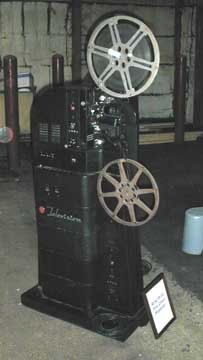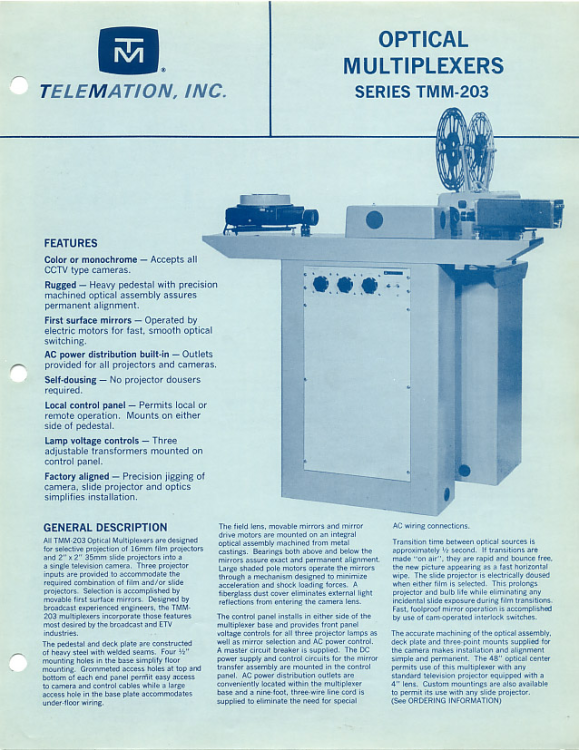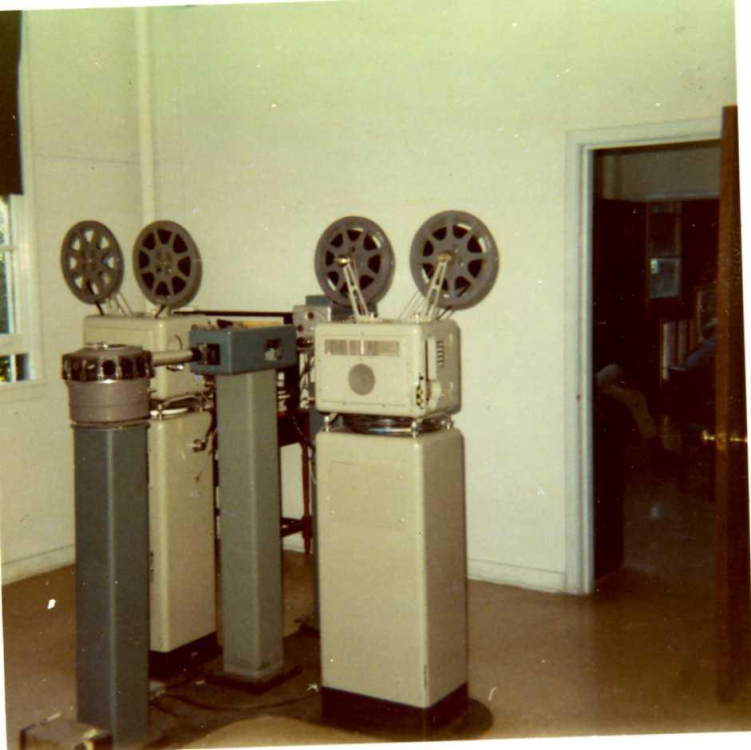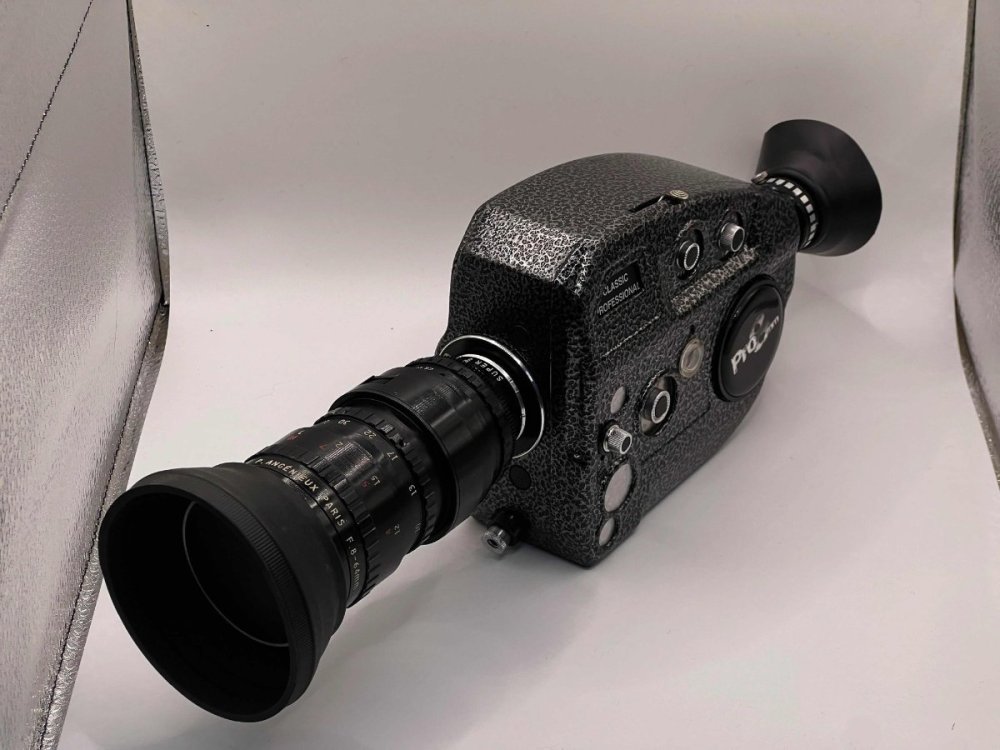-
Posts
966 -
Joined
-
Last visited
Everything posted by Perry Paolantonio
-
And they would promptly go out of business. What part of this are you not getting? An SLR and a machine vision camera aren't the same thing. You can't compare them.
-
I don't know how to respond to this because you're just jumbling up a bunch of terminology. Maybe read up on how log scans and data transfers work?
- 31 replies
-
you don't "set exposure" when doing a data scan. I suspect what you're doing is basically a one-light scan in the scanner, essentially grading the image post-capture in the scanner software. That's different, and is not how most scanners work. And that will definitely allow you to blow out highlights. It's just not how a data scan of film is done, but the FilmFabriek scanner probably doesn't work that way. It has nothing to do with SDR vs HDR scanning either.
- 31 replies
-
If this is how you're scanning film, you're doing it wrong. The exposure of the image on the film is irrelevant.
- 31 replies
-
Then there's a problem with either your scanner or your scanning methodology because this shouldn't happen. If the first shot is set up correctly and you're doing a flat scan, nothing should ever be over or underexposed. We pay for an annual support contract. The system is technically connected to the internet but we don't use it for anything other than scanning. It gets security updates only. We don't touch any other Windows updates on that machine unless necessary, because it works. I don't know what to say. We have half a dozen windows machines here and they're fine. I've been using Windows since the 1990s and while I don't especially like the operating system, it's not something I'd ever describe as "constantly breaking." We are a small shop - 3 of us. I do all the hardware and software maintenance myself. It's not that hard.
- 31 replies
-
- 1
-

-
the latter. The only things I care about are that the image quality is good, the software is reliable, and the machine just works every morning when we come into the office. We pay for software updates and get them regularly. We get support when we ask for it. That's worth it. Who cares what computer it runs on? We have scanned millions of feet of film on our ScanStation in the past 12 years.The PCs they supply with the computer (or with major upgrades) are turnkey and they have worked flawlessly since they arrived. And these are just Win 10/11 machines running on gaming motherboards - I built a few workstations internally using the same hardware because it's been pretty reliable. I'm not about to based the purchase of a scanner on the OS the software runs on, or on waiting for a company to come out with a Mac version vs something that works, immediately, without fail. That's money lost and not a very smart way to run a business. I would argue that very few scanning services work this way. We scan on our ScanStation to the local RAID. Files get copied up to our SAN if we're grading/restoring the film, or they get copied to the client's hard drive if not. We have the scanner in a different room that's just for scanning. Resolve is in a room that's set up for grading - proper monitoring, lighting, wall color, etc. If we do them in the same room, we're tying up the scanner PC to do grading, or we're tying up the grading machine to to scanning. That's the old Telecine model in a sense, and part of why it used to cost $600-$800/hour to do telecine. Because you're tying up hardware that could otherwise be used to do something else at the same time.
- 31 replies
-
- 1
-

-
You're comparing apples to oranges here. Spirit, Arriscan, and Scanity are in a completely different league from the BMD Cintel. They sell for 10x - 20x the price. The Cintel scanner is at the price point it's at precisely because it's not using the kind of custom hardware those other scanners use. All of those high end scanners were designed (at least in their initial iterations) in a time before it was possible to offload all the work to a GPU so you had no choice but to roll your own. A pretty strong argument can be made that that's an outmoded way of designing this kind of hardware given the current state of cheaply available GPUs. I'm not saying they're bad at what they do, but if the engineers who designed them started now, odds are they wouldn't be building it entirely from scratch, they'd be repurposing existing hardware (in fact, this is what the later generation ArriScans do - it's basically an Alexa in there).
- 31 replies
-
This logic makes no sense. I don't even know where to start. Do you have any concept of the work involved in building an embedded system from the ground up with that kind of horsepower? No sane engineer would propose such a thing, when the exact same result can be had using off the shelf, readily available, easily interchageable parts. The engineering resources involved in designing such a beast, and then having to maintain it in small quantities as available components come and go, is absolutely massive.
- 31 replies
-
This seems in keeping with the design of the BMD Cintel overall - a really dumb idea. Why on earth reinvent the wheel, when GPUs and the ability to process images at very high speeds are available off the shelf? Custom building something like this is a terrible idea, for so many reasons. Also, BMD already has extensive programming experience with GPU-based image processing, with Resolve to draw upon.
- 31 replies
-

A Lasergraphics Director scanner on eBay $145K
Perry Paolantonio replied to Daniel D. Teoli Jr.'s topic in Post Production
This machine was sold 2 years ago (this is an old thread) by a surplus company in Texas. It was an older model Director, from before they introduced the 8mm gate. The transport on the older models is fundamentally different than the newer ones (the old ones were sprocketed and made for 16/35 only, the new ones are sprocketless, and the entire layout of the transport is different). I don't believe it could be upgraded to the new version short of sending it back to Lasergraphics and paying for them to heavily modify it (which would probably cost almost as much as a new one, if they'd even do it). -

Early 2000s Film Scanning Question
Perry Paolantonio replied to Ravi Kiran's topic in Post Production
You're talking more at the network, than the station level, which confirms what I said above. Running and maintaining a Rank was a lot more complicated, specialized, and expensive than a simple film chain so it only would have been at a select few locations, mostly at the studio/network level, vs at the local television station. We had an old RCA TP16 film chain in our old office building. I tried to get it before we moved, because the building was supposed to be shut down and nobody wanted it. We never ended up taking it (and now I'm glad because apparently they're filled with asbestos insulation). But it looked like this - a cool, if useless hunk of metal these days. -

Early 2000s Film Scanning Question
Perry Paolantonio replied to Ravi Kiran's topic in Post Production
And this is very similar to the machine I operated, which I can't seem to find any information about: -

Early 2000s Film Scanning Question
Perry Paolantonio replied to Ravi Kiran's topic in Post Production
That workflow isn't exactly right. The 16mm prints distributed to television stations you talk about were typically aired direct to TV using a film chain. This is basically a projector with a 5-bladed shutter, pointing at a camera. We had one in college, that I operated. Absolute nightmare of a machine made by Zeimark. It had a Super 8 projector, a 16mm projector, a dual-dissolving slide projector, and color video camera. All were pointed to a central optical multiplexer. If you wanted 16mm you pressed a button and a solenoid would (very loudly) move the mirror to the projector so its image would reflect into the camera. In a television station, the camera would be fed into the main switcher and that would go direct to air. There was a local station here in Boston that was still showing films this way (channel 68) in the 1990s. It may have been that at some point they copied the film to videotape. The Zeimark we had in college was connected to a Umatic deck, and that's how we used it. But there was no color correction beyond what you could do on a rack mounted frame synchronizer/TBC unit. The telecine you're showing is not what a TV station likely would have had - or at least not most of them. That's the kind of telecine you'd use to make master videotapes in a post production workflow, and it's significantly more complex and expensive than a film chain, requiring dedicated color correction hardware. This is what a film chain looks like: -

Early 2000s Film Scanning Question
Perry Paolantonio replied to Ravi Kiran's topic in Post Production
4k existed in the late 90s, but was mostly used for VFX and specific shots rather than complete features. I think there were quite a few workflows depending on the post/VFX house, but mostly it was 2k at that time. A big part of this was the processing requirements to work in 4k. A lot of stuff was done on lower res proxy footage then the media would be replaced with the high res version for final render. But managing a 4k feature in 2000, when a terabyte was still a lot of data, was a challenge. Most quick-turn transfers were still telecine, so they would have been color corrected on the fly during the transfer, and would have gone to SD or HD videotape. File based capture from telecine was mostly to very expensive DDRs at that time, if it was done at all - mostly you'd go to tape then have to capture that tape to a file in a separate pass. It wasn't until a few years later that you could (very clunkily) hook up a capture board like an AJA Kona or an early Blackmagic Decklink and have it record to a file as if it were a deck (and there were only one or two apps that could do this, I think). Back then everything was still tape-centric, and there weren't a lot of options for machine-controllable digital recorders that ran on desktop hardware. It was mostly proprietary (and very expensive) stuff. -
Have you done restoration using digital restoration software on motion picture film, Daniel? If not, please stop comparing it to still image processing. It is decidedly not the same thing. If you cleaned up every frame of a movie in the same way you did a still image, the result would be an utter disaster -- totally unwatchable. Because, motion. As for dust maps, the question was asked what the IR pass is for, so I answered that. In reality, as I pointed out, it's only marginally useful, and it's only good for certain types of dirt. As Rob mentioned, it's not used often. Many restoration tools don't support dustmaps - MTI does, PFClean does. Phoenix, which we use, does not. I don't know about Diamant. Dustmaps were something that came about 25+ years ago, as a way to speed processing on older computers by limiting the areas processed to those that needed it. This resulted in a better image because you didn't have to analyze the whole frame, which took forever, and the fixes were concentrated only in small areas. There were fewer false positives detected, and that means fewer errors. Most digital motion picture restoration tools work by analyzing the motion in the current frame and surrounding frames and algorithmically coming up with a best case replacement for the pixels there - ideally by pulling those pixels from a frame or two away from the current one, in the same part of the image. Almost always, these require some level of manual override or adjustment. 20 years ago, when I restored my first feature film, the processing power required to do this was enormous and it took over a month to do a feature length film in HD - not even 2k or 4k. For that reason, dust maps make sense in some situations. But nobody has ever said that's the only way to do it. today, on hardware that's orders of magnitude faster, it still takes about a month for one person to do a pristine restoration manually, sometimes longer. All depends on the film. Please stop comparing motion picture tools to still image tools. There are some overlaps but they're not the same and you can't compare the two.
- 16 replies
-
If you decide you want to do it on the ScanStation (6.5k/HDR), get in touch with us - we don't offer rush services per se, but because most of our clients are archives with long project deadlines, we have the flexibility to do fast turnaround on most scanning-only jobs. Typically 1-2 days. We're in Boston, so UPS Ground from NY is overnight to get the film here and back.
- 16 replies
-
Sequential RGB uses a monochrome sensor to make the image. Three images are taken, each with a different color light - Red, Green, Blue. The three channels are combined into a color image. Doing it this way you can do 16 bits per channel, assuming the sensor in the camera is 16 bit. If you bring a color image into Photoshop and look at the R/G/B channel separately, they're represented as monochrome images. This is the same thing, but in reverse. The ScanStation uses a faster Bayer sensor, but with 2-flash HDR and oversampling, the results are in many cases pretty comparable to a sequential RGB scan, in terms of bit depth. IR is only used to create a dirt map that some restoration software can use. In the case of the Director, DICE is built in, so it uses that to do some in-scan cleanup of dirty film. If we had a director, we probably wouldn't use it, because it's not very good and it's baking those "corrections" into the image. But you don't have to have the cleanup done in-scanner. You can just output the straight scan along with a dirt map. This is handy, if your restoration software supports it. The basic idea is that any dirt that's physically on the film will not allow the IR light to pass through. the dirt map is a black and white image, with spots representing the location of the dirt on that frame. It's a second scan made at the same time, to a separate folder. The restoration software (if it supports it) can load that IR map up, and only target fixes where the dirt is. Of course this all sounds great, but doesn't account for dirt that's baked into a print (say, something that was on the negative, then got printed into the film). In that case, it's part of the picture, not physical dirt on the film, so it won't show up on a dirt map. But it can really speed up cleanup on dirty prints because you're not processing the entire frame, just the spots where there's actually dirt.
- 16 replies
-
- 1
-

-

Trying to download DeShaker plugin for VirtualDub
Perry Paolantonio replied to Patrick Cooper's topic in Post Production
I don't use the free one so I'm not sure. But it you could download it and find out. There are some resolution limitations with the free version, and some limits on GPU usage as well, but most of the things you can't do are relatively advanced and most people can get by with those restrictions. I'd give it a shot and see. -

Trying to download DeShaker plugin for VirtualDub
Perry Paolantonio replied to Patrick Cooper's topic in Post Production
This is an incomplete download. It's a temp file made by your browser and when the download is finished it will change to whatever the correct extension is supposed to be. Source code. You'd need to open them in Microsoft Visual Studio and compile the application. If you don't have experience writing C++ code, this is probably not the route for you. I would just try re-downloading the one that failed. Or use something else. VirtualDub isn't exactly a great application, and if you're looking to stabilize footage you might get better results in something like Resolve, which is widely used in a professional setting. -
I'm selling my Pro8mm modified Beaulieu 4008. I just don't use it enough to justify keeping it and maybe someone else can put it to good use. It was completely overhauled by Pro8mm, they added 24fps crystal sync, widened the gate for Max8 (1.58:1), and refinished the original exterior. Comes with an Angenieux 8-64 zoom that's very clean. It has an outboard NiCAD battery pack and sturdy aviation-style connector cable for the battery as well. The battery is supposed to have a capacity of 50 rolls of film, though I've never shot that many so I can't say for sure. It's all packed in a Pelican case. Oh, and I have the manual too. This is a really nice camera and it's pretty rare since they're not offering these for sale anymore with the crystal sync mod. Without crystal sync they sell these for $4000 from Pro8mm. It's located near Boston MA and I'd prefer to do an in-person sale (cash), but could ship it within the US, and do payment with venmo. I'm looking to get $3000 for it. Here are some pictures (click the first picture, it's a link to a flickr album with lots of closeups):
-

How do I transfer a Kemco HoMovie?
Perry Paolantonio replied to Todd Ruel's topic in Post Production
Huh. I've never seen this format. Neat. I don't know about the archivist, but the first place I'd look is in the "Advanced" settings. When you load the film there's a button to show advanced formats (really just uncommon formats). There might be something in there. If not, then this could probably be done with some creative editing, though it would limit the resolution of each frame to 1/4 of the resolution of a full frame, so probably not ideal. You might ask Lasergraphics support as well. If they don't already support it they might add support for this, but they would need to have a film they can keep for testing on their end. If you've got spare film it might be worth a try. -

Transferring vintage Kodacolor lenticular film
Perry Paolantonio replied to Todd Ruel's topic in Post Production
I understand what you're saying, but I guess my point was that I consider that such a basic feature it should simply be considered part of the scanner. I mean, a pin-registered scanner is going to get you basically the same result (at least for non-shrunken film), but it's doing it mechanically. It's just assumed that your image should be stable. That's part of why I don't consider the Filmfabriek, MovieStuff, etc to be serious machines. Sure, but we're talking about kodacolor, which existed for a few years, 100 years ago. It is, by definition, archival film. The odds of it surviving another 20 years without serious shrinkage issues are slimmer now than they were 20 years ago. So the right approach is to get the data captured as best you can and then deal with the color in software. You can apply the same logic from your statement "I always advise my customers not to throw away their films after scanning them, because scanning technology has greatly improved in the last 15 years" to a software based solution, and given that the film will likely not be in the same condition 15-20 years from now, because the software to do this may very well improve over time. -

Transferring vintage Kodacolor lenticular film
Perry Paolantonio replied to Todd Ruel's topic in Post Production
I consider the Lasergraphics scanners to be stable, in terms of image registration. But I don't really consider them to be "doing stabilization," which often has other meanings. We get a lot of clients who apply post stabilization to their scans because they're unhappy about the shakiness of the image. But that shakiness is baked into the picture. The job of the scanner, IMO, is to reproduce the image digitally as faithfully as possible, and then to do fine tuning later. In the case of something shot on a very stable camera, the scan is often all you need because the picture within the frame is stable to begin with. But for stuff shot on cheap cameras like the K3, it's not uncommon to need more work in post. I don't think that really belongs in the scanner. Kind of the same as color grading. We will offer a one-light scan if someone really wants it but we don't do scene by scene in the scanner because it's just not the way modern scanning workflows are designed. With tools like Resolve available for free, and more capable than color correction systems from 15-20 years ago, it makes no sense to break down a film scene by scene in the scanner and apply a grade - that's a lot of wasted time that could be used scanning other film. The color grading tools in Resolve are way better than what you get in any scanner software anyway, so that's the place to do that. So I feel the same about things like lenticular film. I would rather get the best digital reproduction of the film I can, then do the color reconstruction in post, vs permanently baking the color work into the scan. That leaves open the possibility to revisit it later with potentially better color restoration tools too, without having to scan. And on film that's 100 years old, the possibility of not being able to re-scan it 10 years from now is very real.






